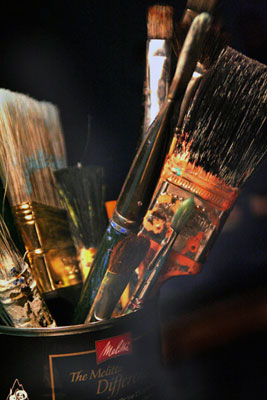All Nonfiction
- Bullying
- Books
- Academic
- Author Interviews
- Celebrity interviews
- College Articles
- College Essays
- Educator of the Year
- Heroes
- Interviews
- Memoir
- Personal Experience
- Sports
- Travel & Culture
All Opinions
- Bullying
- Current Events / Politics
- Discrimination
- Drugs / Alcohol / Smoking
- Entertainment / Celebrities
- Environment
- Love / Relationships
- Movies / Music / TV
- Pop Culture / Trends
- School / College
- Social Issues / Civics
- Spirituality / Religion
- Sports / Hobbies
All Hot Topics
- Bullying
- Community Service
- Environment
- Health
- Letters to the Editor
- Pride & Prejudice
- What Matters
- Back
Summer Guide
- Program Links
- Program Reviews
- Back
College Guide
- College Links
- College Reviews
- College Essays
- College Articles
- Back
Rebel Genius Book Review
Art is magic. Through creative acts, we have the power to transform ourselves and society. In late 2014, this was the seed planted in Michael Dante DiMartino’s head, the same mind from which sprouted the award-winning shows Avatar: The Last Airbender and The Legend of Korra. This concept would be the premise of his next masterpiece. It would give way to DiMartino’s Rebel Genius, a phenomenal fantasy read.
Published in October 2016, Rebel Genius takes place in a Renaissance-inspired world, where in the empire of Zizzola, Geniuses are birdlike creatures that are the physical embodiment of artists’ creativity. However, the Supreme Creator Nerezza has outlawed all Geniuses and art apart from her own. Enter twelve-year-old Giacomo Ghiberti, a boy whose mundane existence is shattered when one night, he discovers that he possesses a Genius. Giacomo and his newfound companion flee to a safe haven for artists, where they learn to channel their creative powers through sacred geometry in hopes of ending Nerezza’s oppressive rule once and for all.
Being a fan of Avatar: The Last Airbender, when I learned that Michael Dante DiMartino had written another book, I just had to read it. It did not disappoint. Despite being DiMartino’s debut in prose writing, Rebel Genius is masterfully executed. The plot is incredibly engaging, a page-turner all the way through. A combination of lengthy, explanatory sentences when discussing sacred geometry, such as “The medium of creation, from which the line, and all geometric forms, are born… building block for the entire universe” and fast-paced, punchy lines when putting it in action, such as “His Genius shot a blue triangle, thin as a knife’s blade” kept me hanging on every word. At first, the cookie-cutter conflict of overthrowing an oppressive ruler seems repetitive and overdone, but the storyline will have you second-guessing as the past makes an unexpected comeback and the boundaries of creativity are tested. Readers will marvel at the way DiMartino develops his magic system, from how aspects of art history are incorporated into the fantastical to how science and art are more entwined than most people believe. Several astonishing twists throughout the plot and DiMartino’s descriptive and vivid style left me stunned and itching to move on to the next chapter.
Furthermore, the imagery and word choice in this book are remarkable. Sentences such as “The storm dwindled into a fog of color, like a painter’s smeared palette” and “High and low notes stacked one on top of another in a swelling, roaring symphony” let readers clearly visualize the immersive fantasy world DiMartino has laid out for them. Phrases like “They entered the courtyard, where enormous black ravens pecked at the bodies of dead guards” clearly set the mood and setting, demonstrating the author’s extraordinary worldbuilding skills. Tension is established through intense scenes such as “But before Giacomo could run, he felt the woman’s spindly arms wrap around his neck, choking him. As Giacomo struggled to free himself, he saw the man reach into his tattered coat and pull out a rusty blade.” DiMartino’s sensational phrasing makes Rebel Genius that much more engaging and enjoyable.
My issues with this book are few in number but notable. First, I found the transitioning to be choppy in certain places. For instance, in one segment of the story, the characters are looking at a map, when all of a sudden, the scene shifts to another set of characters sleeping in a cave. In another portion, two characters are meeting for the first time, but the scene abruptly switches to another group of characters arriving at a castle. The scenes should flow together more fluidly and I’d prefer the transitioning to be a little more subtle. Secondly, the side characters felt slightly one-dimensional. We’re given their backgrounds and personalities, but I wish I could’ve seen them mature and change alongside Giacomo over the course of the story to give them a little more depth. However, this character development could just as easily be expanded upon in a future sequel, and the choppy transitioning is minimal and does not obstruct one’s overall enjoyment of the story.
What makes Rebel Genius such a fascinating read is how you can appreciate it not just as a fantasy novel, but on the metaphorical level as well. One of the most prominent themes in the book is creativity. In a guest blog post he wrote for the website Hypable, DiMartino expressed that Rebel Genius is also a metaphor for the creative process. When DiMartino began writing the book, he expected long hours of blissfully writing away, lost in the world he was creating. But as he explained in the post, “But those blissful moments? They were elusive and impossible to sustain.” DiMartino went on further to say that he experienced much self-doubt while writing the book and was even unsure of publishing it. But as he learned to embrace uncertainty and continue writing despite it seeming daunting, DiMartino was able to push on and write a story he was proud of. The plot of Rebel Genius contains many parallels to DiMartino’s writing experience. Without revealing too much, I can tell you that in the plot, Giacomo also experiences his own self-doubt and like DiMartino said, “He’s inexperienced, unsure of himself, and full of anxiety.” But as Giacomo learns to harness his creativity no matter the risk, by the end of the book, he becomes a more confident, capable, and experienced individual. This creative process is something that all artists, writers, and musicians experience, and the book captures it perfectly.
Rebel Genius is an outstanding book and perfect for anyone looking to immerse themselves in an exquisitely developed fantasy world. The author’s descriptive and vivid writing style, the enthralling plot, an innovative magic system, and the book’s metaphorical representation of the creative process all make Rebel Genius worthy of standing next to DiMartino’s other spectacular works. This story is perfect for helping readers embrace and overcome those times when their imagination hits a roadblock and like DiMartino hoped, it’s a gateway to “inspiring kids, whether they’re into art or not, to use that more creative part of their brains.”

Similar Articles
JOIN THE DISCUSSION
This article has 0 comments.
